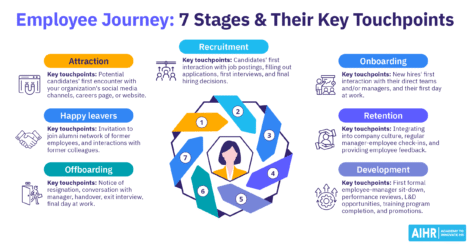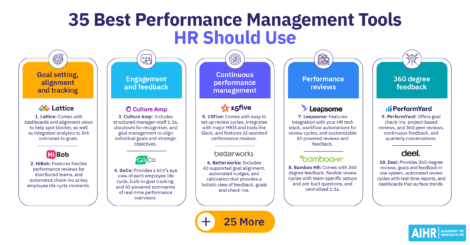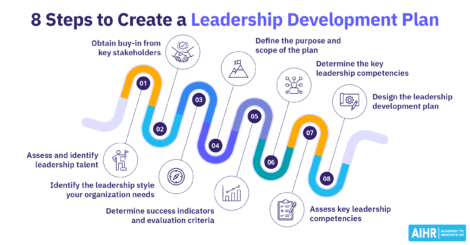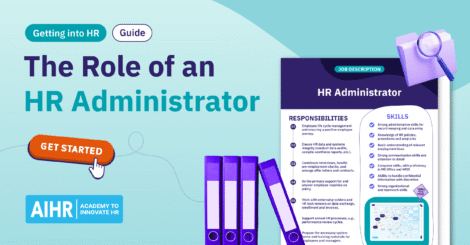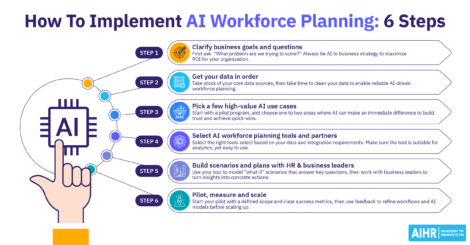An employee review template is one of the most effective tools you can use to deliver consistent, constructive feedback across your organization. In fact, 80% of employees who say they’ve received meaningful feedback recently report being fully engaged at work.
Great managers use feedback to create a development-focused culture closely tied to innovation, productivity, and retention, and detailed template can support this process. This article discusses what an employee review is and how to write one, and how to use template to do so. It also provides a free customizable employee review template to get you started.
Contents
What is an employee review?
What an employee review is not
Why employee reviews matter for HR
Why use an employee review template?
Key elements of an employee review template
Free employee review template
6 types of employee review templates and when to use them
How to write an employee review: 10 HR tips and best practices
Key takeaways
- Employee reviews are structured conversations with written records to set expectations, give feedback, and document performance.
- Reviews align managers and employees and provide evidence for fair pay and promotions.
- Use the right employee review template for the context: annual, quarterly, 90-day, 360, self, and peer.
- Apply evidence-based ratings, 30/60/90 checkpoints, structured 360s, SAR self-reviews, and timed peer input.
What is an employee review?
An employee review (also called an evaluation or performance review) is a structured conversation and written record of an employee’s performance over a set period. Reviews clarify expectations, deliver feedback, set measurable goals, create consistency across teams, ensure documentation, and support engagement and retention.
Because employees work under an employment agreement, organizations must assess performance fairly, transparently, and consistently. A structured review process is a reliable way to meet that responsibility. Employee reviews have several important functions. These include:
- Aligning expectations: Roles and business priorities change; reviews confirm what success looks like now and how the employee’s work maps to company goals.
- Providing feedback: Employees need clear input on strengths and gaps. A structured written review reduces ambiguity and directs effort where it matters most.
- Setting new goals: After evaluating past performance, focus on the future. Set realistic goals to guide staff, and create accountability for them and their managers.
- Supporting pay and promotion decisions: Reviews provide the evidence base for fair compensation and career progression by focusing on results, not opinions.
- Documenting performance: Written reviews create an official record for legal compliance, performance improvement plans, and future decisions.
What an employee review is not
It’s equally important to understand what to avoid when preparing for employee reviews. Firstly, they should not be a surprise. If managers only raise issues for the first time during formal reviews, it suggests that they’re neglecting continuous feedback. Employees should already be aware of areas needing improvement before reviews take place.
Reviews should also not be one-sided critiques but instead, two-way discussions. Employees should have the opportunity to reflect on their own performance, share accomplishments, and discuss challenges. The review meeting should end with agreement on the next steps, not with the employee feeling spoken at rather than spoken with.
Why employee reviews matter for HR
Here’s why employee reviews are important not just for managers and staff but also for you and your HR team:
Consistency across managers
Without a structured process, employee reviews can be inconsistent or even biased. Some employees may get detailed assessments, while others receive only minimal feedback. This damages trust and can create perceptions of favoritism. A structured review process helps assess all staff against the same criteria, making the reviews fairer and more equitable.
Legal defensibility
Reviews serve as a record of performance over time. In cases of disputes or terminations, this is critical. Inconsistent or poorly documented reviews can lead to increased legal risk for your company. Documenting employee reviews to help maintain accurate records ensures you have the information needed to protect both your employees and the organization.
Engagement and retention
Employees who receive regular, meaningful feedback are far more likely to be engaged at work. This, in turn, raises the employee productivity rate and reduces turnover. A structured review process supports this by demonstrating that the organization takes employee development seriously, which then contributes to a higher employee retention rate.
Why use an employee review template?
Here’s how an employee review template can help you ensure a fair, consistent review process:
Consistency
An employee review template helps every manager evaluate staff performance in the same way. This reduces the risk of bias and ensures fair treatment for employees across all teams and departments. When employees know the company relies on identical, consistent criteria and methodologies to assess everyone, they tend to feel more confident in the system.
Clarity
Managers often struggle to provide specific and actionable feedback. An employee review template offers clear prompts that guide them to write comments based on observable behaviors and measurable outcomes. This allows employees to clearly understand what they excel at and should continue doing, as well as where they need to improve.
Efficiency
Preparing for reviews can take up a significant amount of time. A standardized template can make the process more efficient by giving managers a framework to follow, instead of having to start from scratch each time. Over multiple review cycles, templates also make it easier to track performance trends and compare results across different periods.
Detailed documentation
Detailed templates provide formal records of employee performance. These are especially useful when HR and management need to make decisions about compensation, promotions, or performance improvement plans. They can help create audit-ready documentation in case of disputes or lawsuits, protecting the company and potentially reducing its legal liability.
Improved employee experience
Reviews can be stressful — particularly for employees. Knowing exactly what the process entails and what the employee review form will include removes uncertainty and builds trust in the organization across the workforce. A template helps keep the process transparent and staff informed, which, in turn, helps them feel more comfortable and confident.
Scalability
As your organization grows, ensuring consistency across teams will only become more challenging. An employee review template can make it possible to scale the review process across large or distributed workforces, making it equally effective for in-office, remote, or hybrid teams alike. This also allows for more seamless cooperation across the workforce.
Learn how to conduct fair, helpful and consistent employee reviews
To ensure consistently fair and useful employee reviews, you must set clear criteria, train managers, require evidence, run reviews regularly, capture two-way feedback, and audit outcomes for bias and consistency.
✅ Learn to use talent data and reports to optimize talent management practices
✅ Foster a positive employee experience throughout the employee life cycle
✅ Create and sustain a culture to help achieve strategic business objectives
✅ Master modern mobility practices to engage and retain top talent
🎓 Future-proof your HR career with a flexible, online Talent Management & Succession Planning Certificate Program.
Key elements of an employee review template
Below are the essential elements every good employee review template should include:
- Employee and role information: Basic details, such as the employee’s name, job title, department, and review period help create context for the evaluation and establish a clear record of it.
- Rating scale: A clear rating scale (e.g., a behaviorally anchored rating scale) helps managers evaluate performance consistently. A scale of three to five points (with defined meanings such as 1 = “falls below expectations” and 5 = “consistently exceeds expectations”) allows for straightforward comparison.
- Core competencies: These are the skills and behaviors expected of all employees, regardless of role. They may include job knowledge, quality of work, productivity, communication, teamwork, and problem-solving. Evaluating these ensures a balanced view that goes beyond role-specific results.
- Role-specific metrics: Every role has unique key performance indicators (KPIs) or objectives and key results (OKRs). Including these helps tie performance directly to job responsibilities.
- Behavior examples: Include two or three concrete behavior examples using the Situation–Action–Result (SAR) model to ground the review in observable facts by clearly outlining the impact of the employee’s actions on business metrics.
- Goals: Reviews should include a section to assess goals from the previous review period and list goals to achieve by the next review period. Write them in the SMART format: specific, measurable, achievable, relevant, and time-bound.
- Development plan: In addition to performance goals, the template should include development plans. These outline the skills the employee must build, required learning actions, and resources the organization will provide.
- Employee comments: A section for employee input encourages self-reflection and ensures the review is a two-way process. Staff should be able to record their own perspective on their performance, and acknowledge the feedback they’ve received.
- Confidentiality statement: HR should prepare and include a confidentiality statement in the template to assure employees they’ll keep all the information in the review private and confidential. This will build trust and encourage both staff and managers to provide honest feedback.
- Signatures and dates: Finally, the template must include a section for signatures from the manager, employee, and HR to confirm the review has taken place, and that all parties have seen the record.
Free employee review template
Need a clear starting point? Download AIHR’s free employee review template. You can easily customize it to reflect your organization’s goals, culture, and performance criteria. Having a ready-to-use form helps you standardize the process quickly and gives managers the tools they need to conduct effective reviews.
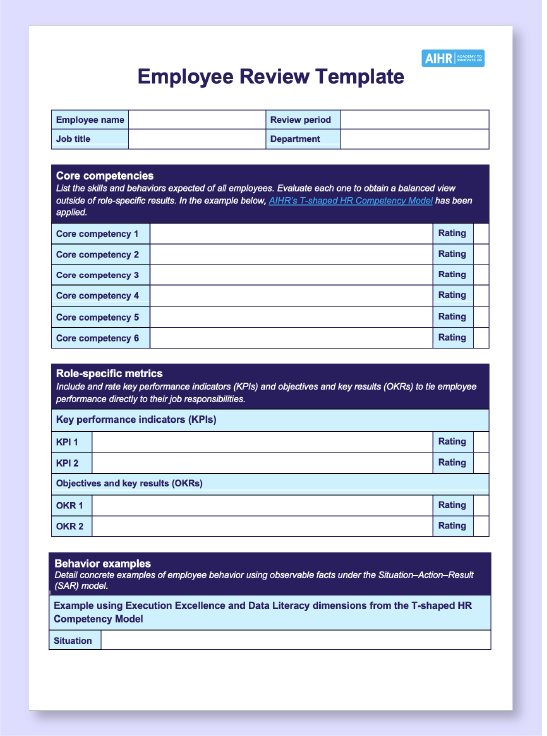
If you want to explore further, AIHR also provides other free review resources that can help you strengthen your review process in every aspect:
Performance review template
A performance review template can help streamline the review process, help employees better understand their development and career progression, and show them how their role contributes to organizational success. This guide shows you how to conduct reviews, and provides two free, fully customizable performance review templates.
90 day review template
A 90 day review template provides a structured framework for assessing and supporting new hires. This article provides a free 90 day review template that can help employees understand the skills and knowledge they need to excel, leading to better performance, engagement, and retention.
360 feedback template
A 360 feedback template can enhance the 360 review process by offering a more well-rounded view of employee performance from multiple sources, focusing on measurable skills instead of personal opinions. This guide shows you how to customize and implement your own, and comes with a free 360 feedback template to get you started.
Employee evaluation template
Employee evaluation templates allow HR professionals to develop a structured approach to assessing each employee’s performance, growth, and potential within an organization. This article looks at various methods and types of employee evaluations, and comes with three free employee evaluation templates (in Word, Excel, PDF).
6 types of employee review templates and when to use them
While there are some essential elements all employee review templates should have, there are a few different types of such templates, each targeting a different kind of employee review. Here are six examples of employee review templates and tips on using them:
1. Employee annual review template
Best suited to company-wide performance evaluations tied to compensation and promotion decisions, this template includes a full set of competencies, a summary of KPIs, a record of year-end achievements, and information relevant to salary adjustments.
Tip: Hold a short calibration session before finalizing ratings, and require three to five evidence-backed results (with metrics or links) to support each rating.
2. Employee quarterly review template
This template is ideal for organizations that operate on fast-moving cycles or use quarterly objectives. It captures progress against short-term goals, identifies blockers, and sets priorities for the next quarter. It also keeps feedback timely and aligned with business needs.
Tip: Limit next-quarter priorities to the top three, and assign an owner and deadline to each blocker to turn issues into clear actions.
3. Employee 90 day review template
Designed for use at the end of a probationary period, this template evaluates if the employee has met onboarding goals, how well they fit into company culture, and early performance indicators. It also highlights training needs to support ongoing development.
Tip: Share success criteria on day one, run quick check-ins at 30/60 days using the same template, and document a clear decision at 90 days (go/extend/exit) with supporting examples.
4. Employee 360 review template
You should use this template primarily for leadership roles or development planning. It gathers feedback from managers, peers, and direct reports to provide a well-rounded view of performance. It incorporates multiple perspectives, making it especially useful for evaluating behaviors like collaboration and leadership.
Tip: Share success criteria on day one, run quick check-ins at 30/60 days using the same template, and document a clear decision at 90 days (go/extend/exit) with supporting examples.
5. Employee self-review template
Employees must fill in this template before their formal review conversations. It gives staff a chance to reflect on their own accomplishments, challenges, and goals. Self-reviews also encourage them to take ownership of their performance, and prepares them for productive discussions with their managers.
Tip: Ask employees to use the Situation–Action–Result (SAR) format for two to three key achievements, and propose two to three goals along with the support they need.
6. Employee peer review template
Particularly useful for cross-functional or project-based roles, this template allows colleagues to provide feedback on collaboration, communication, reliability, and contributions to shared outcomes. Peer reviews highlight aspects of performance that a manager might not observe directly.
Tip: Time peer feedback to land one week before the manager review, request specific project examples, and keep questions focused on observed behaviors, not personality.
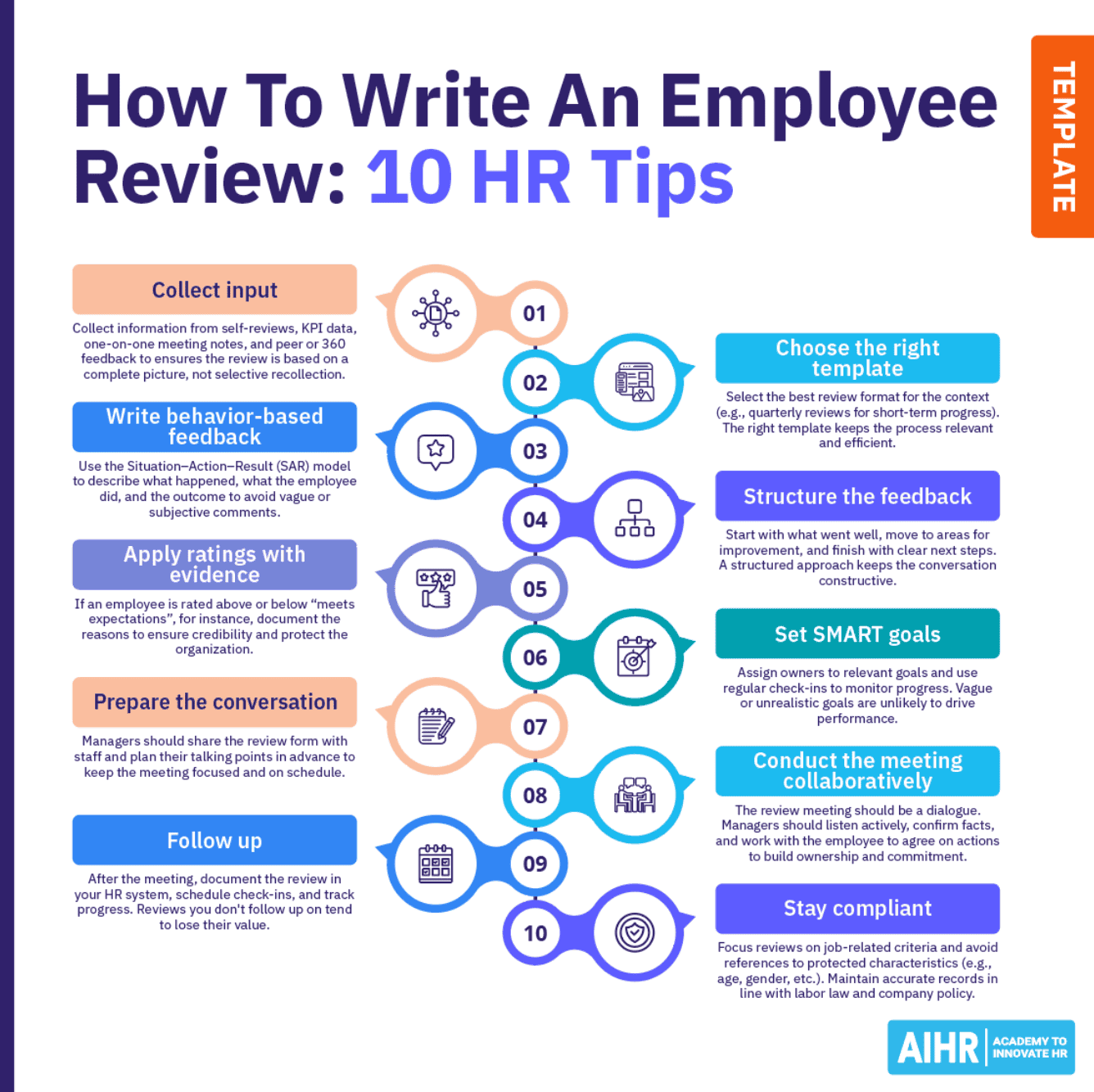
How to write an employee review: 10 HR tips and best practices
Writing fair, helpful reviews requires attention to detail. The following 10 tips and best practices can help you and your managers improve the quality of your employee evaluations.
1. Collect inputs
Don’t rely on memory. Collect information from self-reviews, KPI data, one-on-one meeting notes, and, where appropriate, peer or 360 feedback. This ensures the review is based on a complete picture rather than selective recollection.
2. Choose the right template
Select the best review format for the context. The right template keeps the process relevant and efficient. For instance, annual reviews are tied to compensation, while quarterly reviews focus on short-term progress. The right template keeps the process relevant and efficient.
3. Write behavior-based feedback
When you promote employees into more senior roles, their pay should reflect their added responsibilities. Here, a compensation analysis helps you compare the new role against both external benchmarks and internal peers. This way, you can set a fair, competitive salary that accounts for the promotion while keeping your pay structures consistent.
4. Structure the feedback
Balance is important. Start with what went well, then move to areas for improvement, and finish with clear next steps. A structured approach keeps the conversation constructive and informative, which helps the employee progress.
5. Apply ratings with evidence
Ratings are only meaningful when supported by examples. If an employee is rated above or below “meets expectations”, document the reasons. This helps the organization build credibility, and can protect it in case of disputes or lawsuits.
6. Set SMART goals
Goals should be specific, measurable, achievable, relevant, and time-bound (SMART). Assign owners tot relevant goals and establish regular check-ins to monitor progress. Vague or unrealistic goals are unlikely to drive performance.
7. Prepare the conversation
Managers should share the review forms with staff and plan their talking points in advance. Careful, detailed preparation ensures all meetings are focused, on schedule, and as such, considerate of every employee’s time.
8. Conduct the meeting collaboratively
The review meeting should be a dialogue. Managers should listen actively, confirm facts, and work with the employee to agree on actions they must take in future. This will help employees build ownership and commitment on an individual and team level.
9. Follow up
After the meeting concludes, be sure to document the review in your HR system, schedule check-ins, and track progress. Failing to follow up on reviews will cause them to lose their value and result in wasted time for both managers and employees.
10. Stay compliant
Focus reviews on job-related criteria and avoid references to protected characteristics (e.g., age, gender, ethnicity, etc.). Additionally, be sure to maintain accurate records in line with labor law and company policy.
To sum up
Employee reviews are most effective as part of a culture of continuous feedback, rather than an annual event. Employees who say their managers hold regular conversations with them are three times more likely to be engaged, yet only 21% receive meaningful feedback. A structured employee review template allows for timely, consistent, and actionable feedback.
Additionally, 93% of organizations are concerned about retention, and development opportunities are a major retention driver. A forward-looking review process not only documents performance but also creates space for career growth and L&D. Remember, reviews aren’t just assessments — they’re opportunities to drive engagement and retention.










